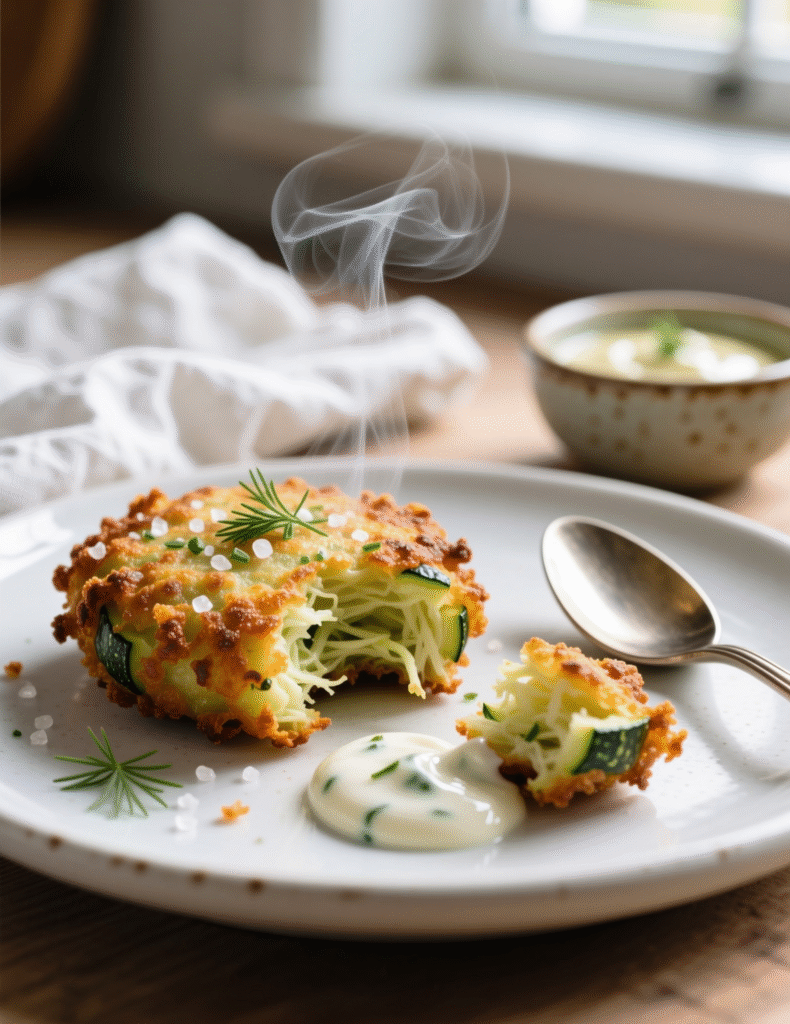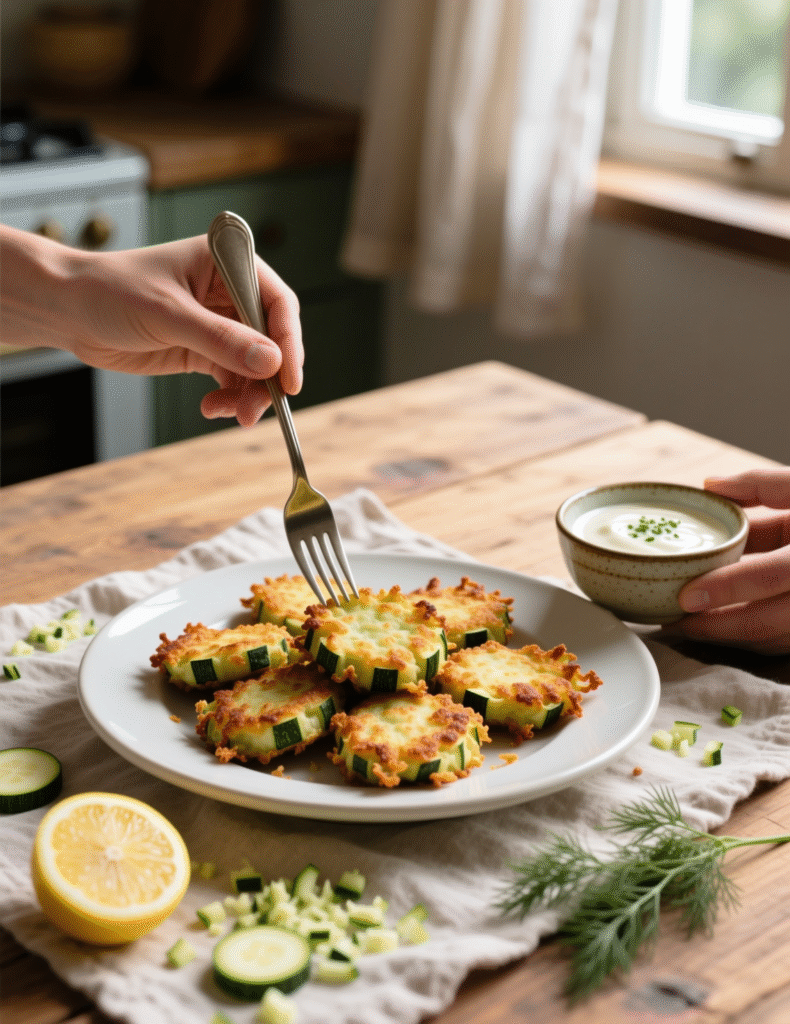There’s something oddly satisfying about the sizzle of zucchini batter hitting hot oil. That faint hiss, the quick puff of steam, and the promise of something golden and crisp—it’s a sound every cook learns to love. This isn’t just another fritter recipe. It’s an exploration into the delicate balance between moisture, texture, and heat—because the perfect crispy zucchini fritters aren’t born by chance. They’re engineered with precision and a bit of instinct.
The Allure of the Humble Zucchini
Zucchini might look plain, almost dull, sitting quietly in the produce section. But this little green wonder has range. It absorbs flavor like a sponge and transforms under heat. In professional kitchens, zucchini is both a friend and a test. Too much moisture? The fritters collapse. Too little seasoning? Flat flavor. But nail the ratio, and you get something magical—crispy outside, soft and tender within, with a mild vegetal sweetness.
Zucchini is 94% water, which makes it a tricky candidate for frying. The goal here is not to fight its water content but to work with it. The secret? Salt, patience, and technique.
Ingredients That Make a Difference
For 8 servings, you’ll need:
- 4 medium zucchinis (around 2 lbs total)
- 1 teaspoon salt (plus more for seasoning)
- 2 large eggs
- 3/4 cup all-purpose flour
- 1/4 cup grated Parmesan cheese
- 2 cloves garlic, finely minced
- 1/2 teaspoon black pepper
- 1/2 teaspoon paprika (optional, but adds a lovely warmth)
- 1/4 cup chopped scallions or chives
- Vegetable oil for frying
The ingredients look basic, but that’s deceptive. Every single one plays a role. Eggs bind. Flour gives structure. Parmesan adds umami depth and crispness. Even a whisper of paprika can shift the flavor profile from mild to compelling.

The Real Work: Extracting Water from Zucchini
This is where most people stumble. Zucchini’s moisture is its greatest enemy when it comes to fritters. Grate the zucchini using a box grater, medium holes. Toss the shreds with salt and let them sit in a bowl for about 15 minutes. Salt draws out the water through osmosis—a gentle science lesson in your kitchen.
Now, the part everyone rushes through—squeezing. You’ve got to press hard. Wrap the salted zucchini in a clean kitchen towel or cheesecloth and squeeze until you think you’ve removed enough liquid—then squeeze a little more. You should end up with a compact pile that feels almost dry to the touch.
If you skip or skimp this step, you’ll never get that crisp edge. You’ll get a soggy, sad pancake pretending to be a fritter.
The Perfect Batter
In a mixing bowl, whisk eggs until smooth, then stir in flour, Parmesan, garlic, pepper, paprika, and scallions. Add the drained zucchini and stir until just combined. The batter should be thick but not doughy. It should drop from a spoon reluctantly, not pour freely.
Here’s the pro trick: let the batter rest for 5–10 minutes before frying. That short rest lets the flour hydrate, giving you a smoother, more cohesive fritter. It’s the same logic behind letting pancake batter sit. Professionals know—tiny pauses make big differences.
Frying: The Heart of the Matter
Oil temperature is non-negotiable. It should hover around 350°F (175°C). Too low, and your fritters soak up oil like sponges. Too hot, and the outside burns before the inside cooks through.
Use a large skillet—cast iron if you’ve got one. It holds heat like a loyal friend. Add just enough oil to cover the bottom generously, about 1/4 inch deep.
Scoop about 2 tablespoons of batter for each fritter and drop them gently into the hot oil. Flatten slightly with the back of a spoon. Fry for 3–4 minutes per side, or until golden brown and crisp. Don’t overcrowd the pan; give each fritter breathing space. You’re not making a stew here—each one needs oil contact to crisp properly.
Transfer cooked fritters to a wire rack or paper towel–lined tray. Season lightly with salt while still hot. That last sprinkle isn’t just for flavor—it helps draw out a tiny bit more moisture from the surface, making them even crisper.
The Science Behind Crispness
Why does crispness feel so satisfying? Food scientists link it to sound and texture—a kind of multisensory harmony. The crunch signals freshness and precision. When moisture inside a fritter turns to steam and escapes, it creates micro-bubbles in the batter. Those bubbles harden into a thin shell when exposed to hot oil.
Too much water and those bubbles collapse. Too much flour and they never form properly. The perfect fritter is a tension between evaporation and coagulation—a science experiment that ends deliciously.
Flavor Layering: Going Beyond Basic
Classic zucchini fritters are mild, but pros never stop there. Try folding in crumbled feta or goat cheese for a tangy lift. Add a bit of grated carrot for sweetness or a dash of cayenne for heat.
Want a Mediterranean edge? Mix in chopped mint, dill, and a squeeze of lemon zest. You can even make them gluten-free with chickpea flour, which adds a nutty undertone and beautiful crunch. The formula stays the same; only the accents change.
Serving Suggestions That Wow
Crispy zucchini fritters are incredibly versatile. Serve them as a starter, side dish, or even a light main. Stack them with a dollop of Greek yogurt and a drizzle of honey—yes, honey—and you’ll be shocked at the harmony of flavors.
For brunch, top with a poached egg and a sprinkle of chili flakes. Or make them the star of a mezze platter with tzatziki, hummus, and roasted peppers.
A fun chef’s trick: reheat leftover fritters in an air fryer at 375°F for 4–5 minutes. They come back to life perfectly crisp, better than microwaving ever could.

The Nutritional Angle
Zucchini fritters aren’t just indulgent. They’re actually pretty nutrient-rich. Zucchini brings fiber, potassium, and vitamin C to the table. The frying adds calories, sure, but in moderation, it’s a balanced dish.
One fritter (if made with the above recipe) clocks in at roughly 150–170 calories, depending on oil absorption. Using olive oil or avocado oil can tilt the health profile slightly better while maintaining that crisp bite.
Common Pitfalls and How to Avoid Them
Too watery batter: You didn’t squeeze enough liquid out. Go back and squeeze harder next time.
Fritters falling apart: Usually too little flour or eggs. They’re your binding agents. Adjust slightly.
Greasy fritters: Oil was too cold. Always test with a small drop of batter—it should sizzle immediately.
Burnt outside, raw inside: Oil too hot. Lower the temperature and fry in smaller batches.
Even pros mess this up occasionally—it’s about rhythm and awareness. The pan speaks if you’re listening.
Modern Takes and Emerging Trends
In fine dining, fritters are evolving. Chefs are now air-frying or oven-baking them to achieve near-identical crispness with less oil. Some use dehydrated zucchini for intensified flavor. Others are replacing flour with almond meal or rice flour for gluten-free appeal.
Zucchini fritters have even found their way into vegan cuisine—flaxseed “eggs” and nutritional yeast step in for binding and flavor. The culinary world is turning this humble peasant dish into a canvas for creativity.
Pro Tips from the Line
- Temperature discipline: Keep a thermometer near your skillet. Even a 10°F drop can change texture.
- Small batches: The more you fry at once, the colder the oil gets. Two or three fritters at a time is ideal.
- Dry batter tweaks: If the batter feels loose after resting, add a spoon of flour. Don’t panic. Adjust, don’t start over.
- Resting after frying: Give fritters a couple of minutes to settle before serving. The steam inside redistributes, keeping the insides tender.
A Word on Texture and Sound
Chefs often talk about taste, but texture? That’s where mastery lives. When you bite into a perfect fritter, the sound—the crisp snap—is a mark of technique. It’s not about over-frying or pushing for darkness. It’s about that precise point where the exterior locks into crunch while the inside stays creamy and moist.
It’s a sound every cook learns to recognize, almost subconsciously. That faint crk as the fork goes in.
The Perfect Dip
Yogurt-based dips are a natural match. Try one made with Greek yogurt, lemon juice, grated cucumber, and dill. Or a spicy aioli with roasted garlic and smoked paprika. Each bite of fritter should meet something cool, creamy, and tangy—it completes the sensory experience.
Even a simple squeeze of lemon works wonders. The acid wakes everything up.
Why This Recipe Works
This version of Crispy Zucchini Fritters works because it respects the vegetable. It doesn’t drown it in batter or hide it under cheese. It lets the zucchini breathe, while structure and seasoning elevate it.
It’s built on culinary fundamentals—moisture control, balanced seasoning, and proper frying technique. Follow those, and you can swap zucchini for corn, carrots, or even sweet potatoes. The science remains identical.
Conclusion: Precision Meets Simplicity
At its heart, this recipe celebrates restraint and skill. It’s about doing a few things well—salting, squeezing, mixing, frying—and trusting that simple ingredients can do the heavy lifting.
When you master zucchini fritters, you’re not just making a snack. You’re learning how to control texture and flavor at a professional level. That’s why so many chefs still obsess over dishes like this—it’s humble, yet it demands discipline.
So next time you grate a zucchini, don’t rush. Let it rest. Listen to the oil. Watch the edges brown slowly. Cooking, after all, isn’t just about taste—it’s about patience, practice, and paying attention to the small sounds of perfection.
FAQs
How do I keep my zucchini fritters crispy?
Drain and squeeze out as much water from the zucchini as possible before frying.
Can I bake zucchini fritters instead of frying them?
Yes, bake at 400°F (200°C) for about 20 minutes, flipping halfway for even crispness.
Why do my fritters fall apart while cooking?
The batter likely needs more egg or flour for binding—adjust slightly.
What oil is best for frying zucchini fritters?
Use a neutral oil with high smoke point like vegetable, canola, or sunflower oil.
Can I make the batter ahead of time?
It’s best to fry immediately, but you can refrigerate batter for up to 2 hours.
How do I reheat leftover fritters?
Reheat in an air fryer or oven at 375°F for a few minutes to restore crispness.
Are zucchini fritters healthy?
They’re relatively healthy, especially if pan-fried lightly or baked instead of deep-fried.
Can I freeze cooked zucchini fritters?
Yes, freeze on a tray first, then store in a container for up to 2 months.
What can I serve with zucchini fritters?
Serve with Greek yogurt, tzatziki, spicy aioli, or even a simple lemon wedge.
Can I make zucchini fritters gluten-free?
Absolutely, just swap all-purpose flour for chickpea or rice flour for a crisp texture.

Marie Smith is a passionate recipe blogger, sharing easy, delicious, and creative culinary ideas that inspire home cooks to elevate everyday meals with flavor and simplicity.
